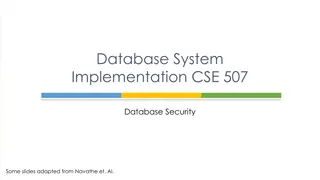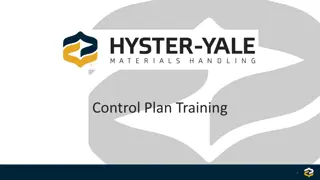Personnel Safety Systems and Access Control at CERN Facilities
Personnel Safety Systems at CERN include ODH detection, fire safety measures, and access control to protect personnel from hazards. Various access control layers are implemented to regulate entry to different parts of the facility, ensuring only trained personnel access underground areas. Biometric verification and equipment checks are used for personnel access, while Material Access Devices facilitate secure transportation of bulky materials. The system also includes Access Points and faces challenges in personnel tracking due to the vast size of the facility.
Download Presentation

Please find below an Image/Link to download the presentation.
The content on the website is provided AS IS for your information and personal use only. It may not be sold, licensed, or shared on other websites without obtaining consent from the author.If you encounter any issues during the download, it is possible that the publisher has removed the file from their server.
You are allowed to download the files provided on this website for personal or commercial use, subject to the condition that they are used lawfully. All files are the property of their respective owners.
The content on the website is provided AS IS for your information and personal use only. It may not be sold, licensed, or shared on other websites without obtaining consent from the author.
E N D
Presentation Transcript
2 PERSONNEL SAFETY SYSTEMS Tomasz Ladzinski for CERN EN-AA Group
Personnel Safety Systems Systems installed to protect the personnel from hazards inherent to the facility. ODH Detection Fire Safety Interlock Detection Access Control Alarm Systems Fire Protection
4 Access Control Control who can enter and who is inside the FCC Several layers of access control: site, building, access to the underground and access to the interlocked parts of the FCC. Access to the Service Caverns and Klystron Galleries possible while the FCC is operating with beam. Achieved with appropriate design of civil engineering and shielding; Nevertheless, the surface access point should provide a non-penetrable barrier to control that only properly trained personnel enters underground; track in a non-ambiguous manner the number of people underground. Access control is built using consumer-off-the-shelf components, integrated to form one system, following principles applied throughout the CERN accelerator complex.
5 Personnel Access Devices All checks in one place Inviolable barrier, guaranteeing only one identified person enters at a time. Verification of all access authorizations: facility access rights, training, activity coordination approval. Biometric confirmation of identity. Checks of equipment, such as passive and active dosimeters. Limits the number of people in a given location, so as not to exceed safe pressurized area and vehicle capacity. Same concept retained for the FCC, some components may eventually be very different (e.g. the biometric identification), as part of a rapidly evolving IT segment.
6 Material Access Device Safe way to bring in/out bulky material Inviolable barrier, guaranteeing that only material can be brought in/out and nobody trespasses. Size matching the size of the lift. Today s devices equipped with a combination of off-the-shelf volumetric detectors and custom image processing algorithms. Same concept retained for the FCC, individual components may eventually be very different (e.g. human presence detection), as part of a rapidly evolving IT segment.
7 Access Point Example Location Point H (RF) 1 non-interlocked surface Access Point (2 x PAD, 1 x MAD) 1 interlocked underground Access Point to the tunnel (1-2 x PAD, 1 x MAD) 2 interlocked underground Access Points from Klystron gallery to RF section (1 x PAD, 1 x MAD)
8 Access Control Challenges Personnel Tracking The size of the FCC is unprecedented. In a worst-case scenario, the evacuation path may be almost 12 km long. Having a detailed count of people inside, as well as a good vision of everybody s location inside is important for safety. The protection offered by the access control system, which can only tell what access point was last used by a given person does not seem sufficient. It is proposed to track in real time the location of every person and vehicle, by means of individual RFID tracking devices. Such systems have been used e.g. during the construction of the Gotthard Tunnel. Antennas to be installed inside the service areas, access tunnels and alcoves.
9 Access Safety (Interlock) Allow the operation of access only when there are no beam hazards and the operation of beam only when there is nobody accessing. Given the similarities with the LHC - machine entirely underground, 8 regularly spread sites - the Access Safety (a.k.a. Access Interlock) System architecture will be built on the same model as the LHC Access Safety System, with 9 controllers (8 sites + central). Detailed access sectorization to start as soon as main underground parameters (tunnels, number of alcoves etc.) are frozen. Need to identify the EIS-beam (Beam Elements Important for Safety), for both the FCC Collider and the Booster. The beam dump system likely to become the main part of the safety interlock.
10 Access Safety Evolution Patrolling 91 km long tunnel Need for new patrol concepts and procedures, especially for the FCC ring tunnel. The number of patrol sectors comparable with the LHC; it is not foreseen to divide the FCC arcs into smaller units. Incorporate a robot to minimize need for tedious human search use video detection algorithms. Systematic patrol of the alcoves. Envisage moving from cabled patrol boxes to more modern way of enforcing a patrol route.
11 Fire Detection Baseline Solution The current safety concept advocates installation of a generalized early fire detection, which is best obtained with aspirating smoke detectors (ASD). A special Long range ASD has been developed and deployed in the SPS Complex it is capable of detecting smoke aspired with a 100m long sampling segment that can be prolonged with up to 700m of non-sampling tube. With the current proposal of having alcoves every 1500m, it is possible to install 15 L-ASDs in each alcove and aspire air 700-800m left and right of the alcove.
12 Fire Detection Alternatives Early vs maintainable fire detection in the tunnel Drawbacks of the current baseline solution: complex network of tubes (~400km), the sampled air should be returned from the alcove heat dissipation from the pumps in the alcoves (750W/pump) big number of centrals (one in each alcove: ~60 units) Generalized smoke detection in L-ASD version is possible, but not well adapted to the 91 km FCC. Detection faults may lead to FCC availability issues: SPS 1-2 events/year -> FCC ~1-2 events/month Envisage less generalized detection (decision to be made once the ventilation concept is confirmed). Consider other techniques detection in long tunnels best achieved with distributed temperature sensing. Optical fibre prototype installation planned in LHC Point 4 during YETS24/25. Combination of several technologies.
13 Fire Protection - Compartments Upon fire detection, close the compartments Closure of the doors usually achieved with spring loaded mechanism and release of retention magnets. The challenge is not the instrumentation interface with the safety system, but the construction of the fire partitions and the possibility of opening/closing the fire doors in all ventilation settings. Should longitudinal ventilation be introduced, space in the partitions for make-up air passage from one compartment to the next must be made available.
14 Hot Smoke Extraction Upon fire detection, extract the hot smoke No past experience in the CERN accelerator complex. Ongoing project for 300 m long HL-LHC galleries. Construction, and maintenance over the FCC lifetime, of eight 11.4 km long, normally unused, air-tight ducts with fire resistance of 400 degrees is challenging. Two approaches to damper control in the host states: Smoke extraction control is provided by the supplier of the smoke extraction system, it receives signals from the fire detection system. Each damper is controlled by an off-the-shelf Mise-en-Securite-Incendie system (SMSI) centralized fire safety system. Implementation choice of the Hot Smoke Extraction control system partly depends on the FRS requirements (in-line with SMSI or not?, will local fire brigade intervene? etc.)
15 Oxygen Deficiency Hazard Detection Detect drop in oxygen level ODH detection is required in the two RF points: H & L. ODH system and detectors in the LHC based on commercial solution with the oxygen sensor remotely connected (max distance 900 m.) to avoid placing electronics in the tunnel. In 2023 a call for tender for consolidation of the LHC system took place resulting in the choice of the same robust and proven technology. It is the baseline choice for the FCC. Alternatives: aspirating detectors or fiber detection.
16 Evacuation Systems Sirens or Voice Alarm Systems Currently the two solutions co-exist at CERN. In addition to a waring signal, the voice alarm systems offer means of passing additional information to the users, but are not well suited for big and noisy volumes. ~3 600 speakers only to cover the FCC ring tunnel. Adaptive evacuation direction signage Lights, panels or luminous bands. Spacing to be determined, at least in front of every alcove and next to each compartment door. Time consuming testing. Potentially inducing error with a spreading fire, screens with detailed information can also be installed in the alcoves.
17 Call Points Break-the-glass Consumer-off-the-shelf and robust. Ideally to be combined with other safety equipment: emergency lights, telephones, loudspeakers into modulable panels. Emergency Telephones Hard-wired alarm and voice communication directly to the fire brigade. No modern radiation-hard solution exists today as an alternative. Need for R&D of a RadHard solution for digital type devices or special production of old technology type units. Alternatively, equipping only the alcoves and relying on fire resistant leaky cable for the rest of the tunnel.
18 Conclusions No showstoppers, but it s just the beginning of analysis and design The FCC safety concept relies on provision of several safety systems. Their implementation for the FCC looks achievable with the currently available technologies, with the generalized early fire detection and hot smoke extraction systems remaining today a big challenge. Alternatives need further investigation and a more methodological analysis, especially in the domain of fire safety where CERN has historically relied on commercial solutions. Involving industrial partners already during the risk analysis and conceptual design phases should increase the completeness of the study and provide feedback to possible next iterations of improved safety concept. Fire and Rescue Service intervention concept may add new requirements and new systems that have not been analyzed so far e.g. automatic fire suppression.
19 Thank you for your attention!























